|
|
|
Sort Order |
|
|
|
Items / Page
|
|
|
|
|
|
|
| Srl | Item |
| 1 |
ID:
124552
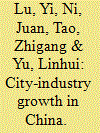

|
|
|
|
|
| Publication |
2013.
|
| Summary/Abstract |
This paper investigates the relevance of two leading theories of city-industry growth (i.e., specialization and diversity theories) in accounting for the fast yet uneven growth of industries in China's cities. Using a comprehensive dataset of manufacturing industries in 231 China's cities for the period 1998-2005, we find that specialization promotes city-industry growth, whereas diversity has no effect at all. In addition, we find that specialization is important for the growth of mature industries in China, but diversity is crucial for the development of China's relatively new and fast-growing industries. Our study contributes to the literature by examining the relevance of the specialization and diversity theories for a large and fast-growing developing economy.
|
|
|
|
|
|
|
|
|
|
|
|
|
|
|
|
| 2 |
ID:
124564


|
|
|
|
|
| Publication |
2013.
|
| Summary/Abstract |
We empirically analyze the host-country determinants of Chinese outward direct investments (ODI) in the period from 2003 to 2008, using disaggregated data by country and sector and distinguishing between state-owned or controlled enterprises (SOEs) and privately-owned firms. Our results show that the pattern of Chinese ODI differs according to corporate ownership. Private firms are attracted by large markets and host-country strategic assets and are averse to economic and political risks when choosing investment locations abroad. Differently, state-owned or controlled enterprises follow the strategic needs of their home country and invest more in natural resource sectors, being largely indifferent to the political and economic conditions in the host countries.
|
|
|
|
|
|
|
|
|
|
|
|
|
|
|
|
| 3 |
ID:
124546
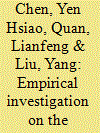

|
|
|
|
|
| Publication |
2013.
|
| Summary/Abstract |
This paper employs a structural time series model designed with three components of stochastic seasonality, trigonometric expression of cyclicality and local linear trend to investigate the evolutionary process of China's GDP. In particular, the model is able to detect the stop-go feature of China's economic growth, i.e., growth cycle, as well as business cycle. The empirical result suggests that most variation in China's macroeconomic performance came from business cycle. The investigation of the three components along with historical events suggests that the Chinese economy had been largely influenced by political activities up to the early 1990s. In the mid-1990s China entered a period of stable and highly growing economy, thanks to the economic reform and the successful implementation of macroeconomic policies. However, since the mid-2000s China has become more sensitive to the turbulences in international markets. In the foreseeable future, the challenge facing China is a more volatile economy with possible slowdown in the economic growth, although the growth rate would still be high compared to developed economies.
|
|
|
|
|
|
|
|
|
|
|
|
|
|
|
|
| 4 |
ID:
124547
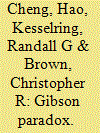

|
|
|
|
|
| Publication |
2013.
|
| Summary/Abstract |
Recent literature has advanced the view that the Gibson paradox, or the positive correlation of the price level with nominal interest rates, is nearly always a gold standard phenomenon. We argue that the Gibson correlation is more accurately classified as a statistical artifact of commodity money systems, with the gold standard merely representing one such system. Using new evidence from Chinese monetary history, this article gives evidence that the Gibson paradox appeared during China's silver-cored metallic standard era. Estimates obtained from recursive ordinary least squares specifications and vector auto-regressions performed, using the Shanghai Yinchai Rate and the Chinese Wholesale Price Index, confirm a Gibson correlation for China during the period 1873-1924.
|
|
|
|
|
|
|
|
|
|
|
|
|
|
|
|
| 5 |
ID:
124545
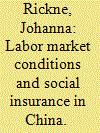

|
|
|
|
|
| Publication |
2013.
|
| Summary/Abstract |
This paper provides micro-level evidence on the relationship between labor market conditions and social insurance participation among Chinese industrial firms. I find that the increased scarcity of labor over this period was a quantitatively important driver of participation. Moreover, a comparison of the responses in different segments of the labor market shows that the response was relatively stronger in sectors with larger shares of uninsured workers, namely in private firms, those with a larger share of low-educated workers, and those without labor unions. The results suggest that a tighter labor market in the years ahead can aid policy makers to implement social insurance programs and combat insurance inequality.
|
|
|
|
|
|
|
|
|
|
|
|
|
|
|
|
| 6 |
ID:
124563
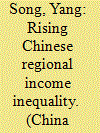

|
|
|
|
|
| Publication |
2013.
|
| Summary/Abstract |
This article examines the quantitative effects of the Chinese fiscal system on the increasing regional income inequality in China, from 1978 to 2007. Fiscal decentralization is a multifaceted concept not likely to be captured by a single measure. This paper investigates the evolution of three aspects of fiscal decentralization including spending decentralization, revenue decentralization, and autonomy power, and tests the effects of each aspect on the regional income inequality in China in the past thirty years. Several critical findings were obtained through econometric analysis. The fiscal decentralization on spending side in China has contributed to rising income inequality over the last three decades. On the revenue side, the fiscal system became more decentralized from mid-1980s to 1994, and re-centralized after the 1994 tax sharing reform. The econometric analysis shows that the increase in revenue share of local governments from mid-1980s to 1994 indeed increased regional inequality, while the revenue re-centralization in 1994 only had a modest effect on reducing regional inequality. In terms of autonomy power measured by how public spending at local level of government is maintained by its own revenue, the degree of fiscal decentralization decreased since mid-1980s, and experienced a sharp reduction in 1994 due to the tax sharing reform. The autonomy power has mixed effects on regional inequality in the two periods, before and after the 1994 reform, depending on the targeting of fiscal transfers and the incentives of local governments. As it turns out, fiscal decentralization may not be automatically equalizing or anti-equalizing, whereas how fiscal decentralization is promoted is important for how it impacts regional inequality.
|
|
|
|
|
|
|
|
|
|
|
|
|
|
|
|
| 7 |
ID:
124553


|
|
|
|
|
| Publication |
2013.
|
| Summary/Abstract |
We provide a sector perspective on the drivers of Chinese outward foreign direct investments (ODI) by analyzing the automotive sector over the years 2006-2011. Following the widespread literature on host-country determinants of foreign direct investments (FDI), we distinguish among economic, institutional and technological factors. We find that Chinese automotive ODI are mostly driven by the market size of host economies - a result which is robust to alternative specifications - but important non-linear effects are at work, i.e. their market-seeking investment strategies are targeted to non high-income countries. Moreover, macroeconomic stability and efficient labour markets both act as attraction factors, while the same does not seem to be true for political stability. Finally, we detect important national- and sector-agglomeration effects.
|
|
|
|
|
|
|
|
|
|
|
|
|
|
|
|
|
|
|
|
|